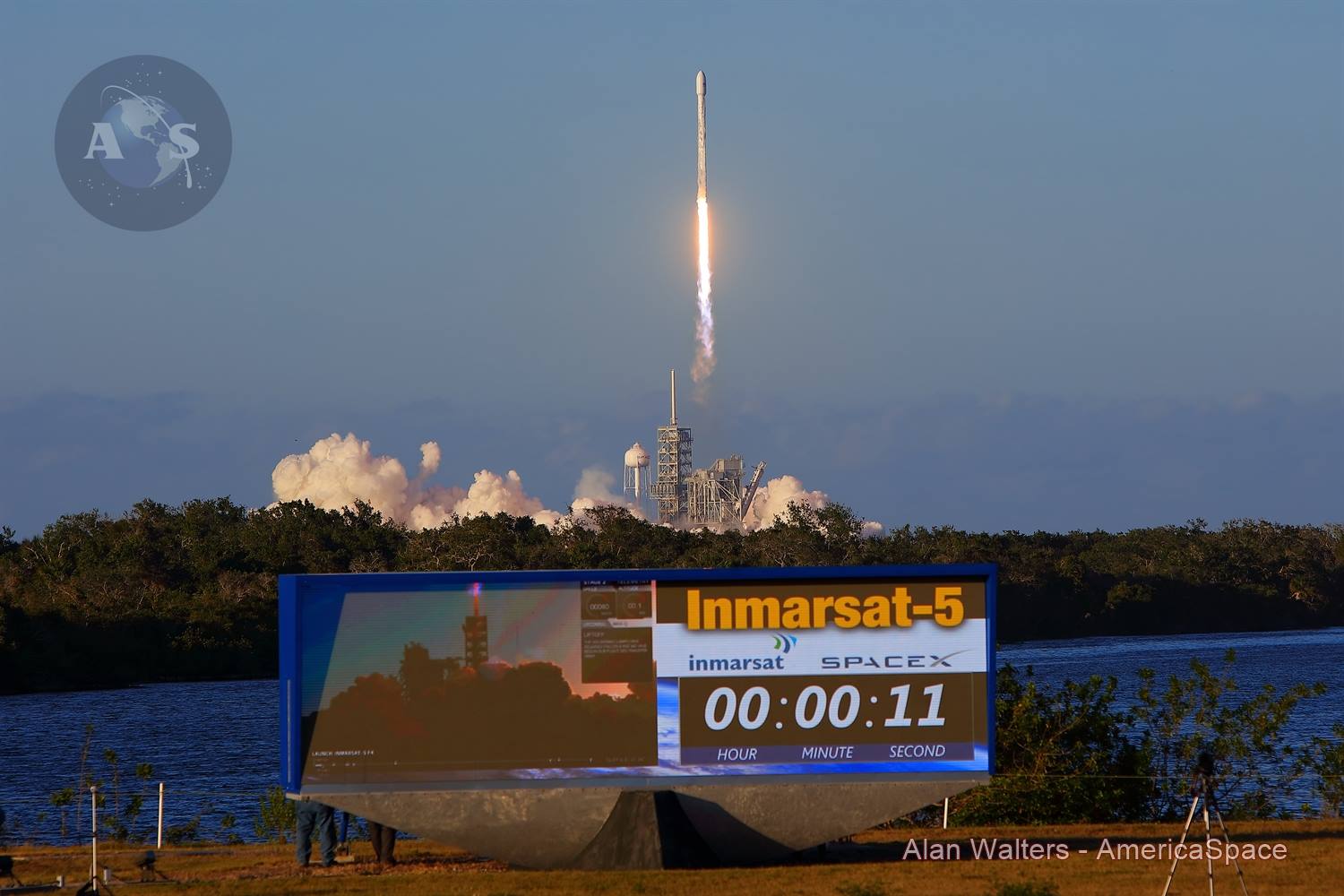
Six months shy of five decades since its first launch, historic Pad 39A at the Kennedy Space Center (KSC) in Florida is primed and ready to stage a landmark 100th mission in the coming weeks. Earlier tonight (Monday, 15 May), SpaceX successfully launched its workhorse Upgraded Falcon 9 booster on an ambitious mission to deliver the heavyweight Inmarsat 5-F4 communications satellite to Geostationary Transfer Orbit (GTO). Liftoff of the 230-foot-tall (70-meter) booster occurred on time at 7:21 p.m. EDT, right at the start of Monday’s 49-minute “window”.
A little under 32 minutes later, the 13,450-pound (6,100 kg) satellite was deployed, after which its on-board Liquid Apogee Engine will commence the climb to its operational orbital slot, at an altitude of 22,236 miles (35,786 km).
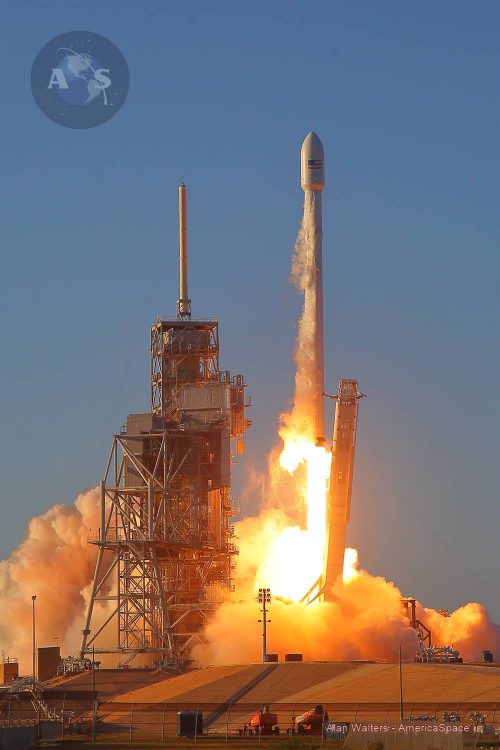
Founded in London in 1979, the International Maritime Satellite Organisation sought to establish a satellite communications network initially for the maritime community, although this remit was expanded in the late 1980s to include improvements to aeronautical communications for public safety. Over the years, Inmarsat technologies have been leveraged for disaster relief, the distribution of aid and the provision of communications support in the catastrophic aftermath of Typhoon Haiyan in the Philippines in November 2013.
In August 2010, the organisation contracted with Boeing to build three Inmarsat 5 satellites, as part of the $1.6 billion Global Xpress endeavor. This was intended to form the world’s first globally available, high-speed mobile broadband service of up to 50 Mbps for deep-sea vessels, in-flight connectivity for airline passengers and the streaming of high-resolution video, audio and data transmissions. Moreover, it was hoped that Global Xpress would empower communities across the world to benefit from an emerging digital society. Earlier this month, after one year of operation, Inmarsat’s Fleet Xpress service—powered by Global Xpress—secured commitments from over 10,000 ships to integrate high-speed broadband into their vessels.
Each Inmarsat-5 was based upon Boeing’s proven BSS-702HP satellite “bus”, equipped with a pair of five-panel ultra-triple-junction gallium arsenide solar arrays to provide about 15 kilowatts of electrical power at Beginning of Life and 13.8 kilowatts at End of Life. An integrated Xenon Ion Propulsion System (XIPS) affords orbital station-keeping and each Inmarsat 5 carries 89 Ka-band transponders with flexible global coverage.
The first of these satellites, Inmarsat 5-F1, was launched in December 2013 by a Russian Proton-M booster from Baikonur Cosmodrome in Kazakhstan and currently provides Ka-band global data services over Europe, the Middle East and Africa. Inmarsat 5-F2 and Inmarsat 5-F3 followed aboard subsequent Proton-Ms in February and August 2015 and cover the Americas and the Asia-Pacific region, respectively. In the meantime, a fourth satellite had been ordered as a spare in October 2013 and was pressed into service as Inmarsat 5-F4.
In addition to its early role as a flight-ready spare for its three cousins, it sat at the center of “an incremental business case…to increase capacity and strategically enhance network coverage”. According to Inmarsat CEO Rupert Pearce, the 5-F4 bird allowed the organisation to “physically insure our global service date” and “consider incremental opportunities that have emerged and could drive enhanced returns”. It was highlighted at the time that the fabrication of Inmarsat 5-F4 at Boeing Space Systems’ El Segundo, Calif., facility, would cost up to $250 million.
Launch contracts for the fourth satellite were awarded to SpaceX in July 2014, with early speculation that the heavyweight payload might fly aboard the Falcon Heavy booster. However, the provisions within the contract allowed for the possibility of using the standard Falcon 9 for enhanced launch readiness flexibility. “In order to ensure launch availability for mid-2016, in line with the fourth-satellite delivery schedule, Inmarsat has secured a SpaceX launch vehicle,” Inmarsat noted at the time. As circumstances transpired, delays induced by two Falcon 9 failures in June 2015 and September 2016 pushed the Inmarsat 5-F4 launch further to the right, eventually into the second quarter of 2017.
Late in April, Inmarsat tweeted that their bird had arrived in Florida for pre-launch testing and the four-day process of loading 5,372 pounds (2,437 kg) of orbit-raising and station-keeping propellants. Last Wednesday, the double-decker-bus-sized satellite was encapsulated within its payload fairing, as it disappeared from view for what was expected to be the last time. “@Boeing & Inmarsat teams say goodbye to #I5F4 as it’s encapsulated into the payload fairing in prep for @SpaceX launch on 15 May,” the organisation tweeted Friday.
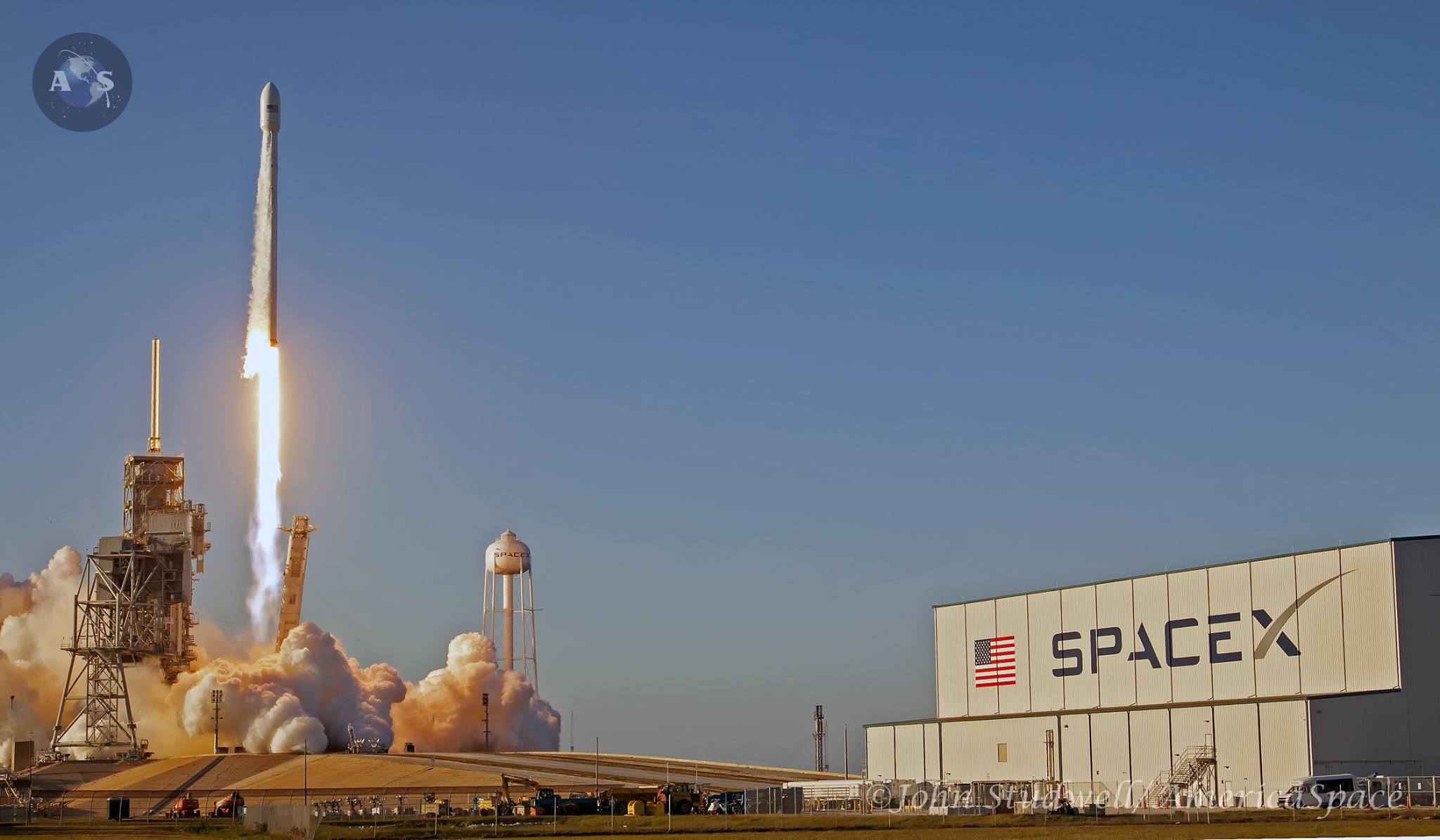
Tonight’s launch represented the 99th flight from Pad 39A, a complex which has seen some of the most historic missions ever conducted in the annals of space exploration. From the maiden voyage of the Saturn V in November 1967 to humanity’s first piloted expedition to lunar orbit in December 1968 and the effort to plant U.S. boots on the Moon in July 1969, the complex hosted no fewer than 12 Apollo-era missions, bookended by the launch of the Skylab space station in May 1973. It then underwent significant modification and between April 1981 and July 2011 supported 82 Space Shuttle launches, before NASA handed it over to SpaceX on a 20-year lease in April 2014 for Falcon 9 operations. Between February 2017 and tonight’s launch, Pad 39A has staged five flights for SpaceX. The historic complex’s landmark 100th mission is expected to be the CRS-11 Dragon cargo flight to the International Space Station (ISS), currently scheduled for 1 June.
In readiness for the opening launch attempt, the 230-foot-tall (70-meter) Upgraded Falcon 9 was transferred from the Horizontal Integration Facility (HIF) to the pad on Thursday, 11 May, and was elevated to the vertical by means of the Transporter-Erector (TE). A brief Static Fire Test of the nine Merlin 1D+ engines on the rocket’s first stage was conducted without incident, later that evening. In accordance with rules implemented after last September’s on-the-pad explosion of the Amos-6 vehicle, payloads are installed atop the booster after the completion of the Static Fire Test.
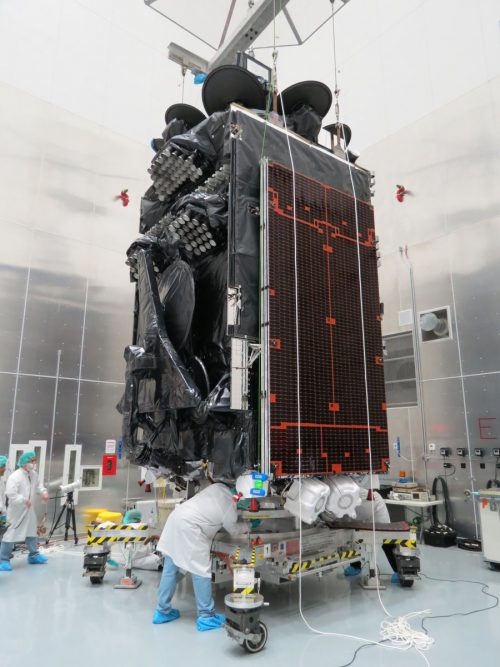
The Upgraded Falcon 9 was accordingly returned to the horizontal and taken back to the HIF, where Inmarsat 5-F4—encapsulated within its bulbous payload fairing—was installed and the vehicle was restored to Pad 39A over the weekend. According to SpaceX, the primary launch window of 49 minutes extended from 7:21 p.m. through 8:10 p.m. Monday, with Eastern Range confirmation of a backup attempt at the same time on Tuesday evening. Weather conditions for both days were predicted to be 80-percent-favorable, with the 45th Space Wing at Patrick Air Force Base noting the Cumulus and Anvil Cloud Rules, together with Liftoff Winds, as possible violating factors.
“A boundary associated with a low-pressure system is moving through the Space Coast, allowing some cooler and drier air to filter in as surface winds switch northeasterly,” the 45th explained in its L-1 Weather Briefing, issued at 10 a.m. EDT Monday. “Winds will remain onshore Monday, pushing most sea breeze cumulus clouds inland. There is a slight chance of afternoon storms near Florida’s Big Bend, which could shed anvil cirrus back over towards the Spaceport.” The cumulus cloud risk centered on the onshore flow, whilst the anvil cloud risk came from inland storms, with an expectation that easterly winds would increase on Tuesday as a high-pressure ridge builds in.
As Monday progressed, the weather outlook brightened to 90-percent favourable, characterized by sunny skies and northeasterly surface winds. “The sea breeze cumulus clouds will remain mostly shallow, due to dry air aloft over the Spaceport,” the 45th reported in its 3 p.m. EDT update. “The primary concern today is a rogue, deeper cumulus cloud associated with onshore flow.”
Since the Amos-6 failure, the Upgraded Falcon 9 has been put through a slightly longer fueling regime and this mission was no exception. About 73 minutes before the opening of tonight’s window, the Launch Conductor polled his team for a “Go/No-Go” decision, after which the loading of rocket-grade kerosene (known as “RP-1”) got underway. At 45 minutes before T-0, liquid oxygen began flowing aboard the Upgraded Falcon 9. “Launch vehicle Ox loading has started,” Inmarsat tweeted at 6:52 p.m., before verifying that the satellite, booster and weather remained Go for launch.
Passing T-10 minutes, the terminal countdown autosequencer was initiated and the nine Merlin 1D+ engines of the first stage—configured in a circle of eight, with the ninth at the center—were chilled down, ahead of ignition. At T-2 minutes, the Air Force Range Control Officer declared all ground assets as “Go for Launch” and the Upgraded Falcon 9 transitioned top internal power and assumed primary command of all critical functions, going into “Startup” a minute before launch. At T-3 seconds, the nine Merlins roared to life, pumping out a combined thrust of 1.5 million pounds (680,000 kg). Liftoff occurred on-time at 7:21 p.m. EDT, about 45 minutes prior to local sunset.
Flying for the 14th time in its Upgraded configuration, and embarking on SpaceX’s 34th mission of a Falcon 9 vehicle since June 2010, the rocket powered smoothly uphill for the first 2.5 minutes of flight. The nine Merlins shut down on time and the first stage separated, allowing the Merlin 1D+ Vacuum engine of the second stage to pick up the baton and deliver Inmarsat 5-F4 to GTO.
At this stage, the flight profile differed significantly from most previous missions. Tonight’s Upgraded Falcon 9 was distinct in that it lacked the four landing legs, hypersonic grid fins and other support structure necessary to execute a controlled touchdown, either on the Autonomous Spaceport Drone Ship (ASDS) in the Atlantic Ocean or at Landing Zone (LZ)-1 at Cape Canaveral. The mass of the Inmarsat 5-F4 payload tipped the scales at 13,450 pounds (6,100 kg) and, coupled with the high orbit, required maximum performance from the booster and left very little propellant in reserve to execute boost-back and landing “burns”. This was the second fully expendable Falcon 9 of 2017, coming on the heels of EchoStar-23 in March, another heavyweight mission which did not feature a landing attempt.
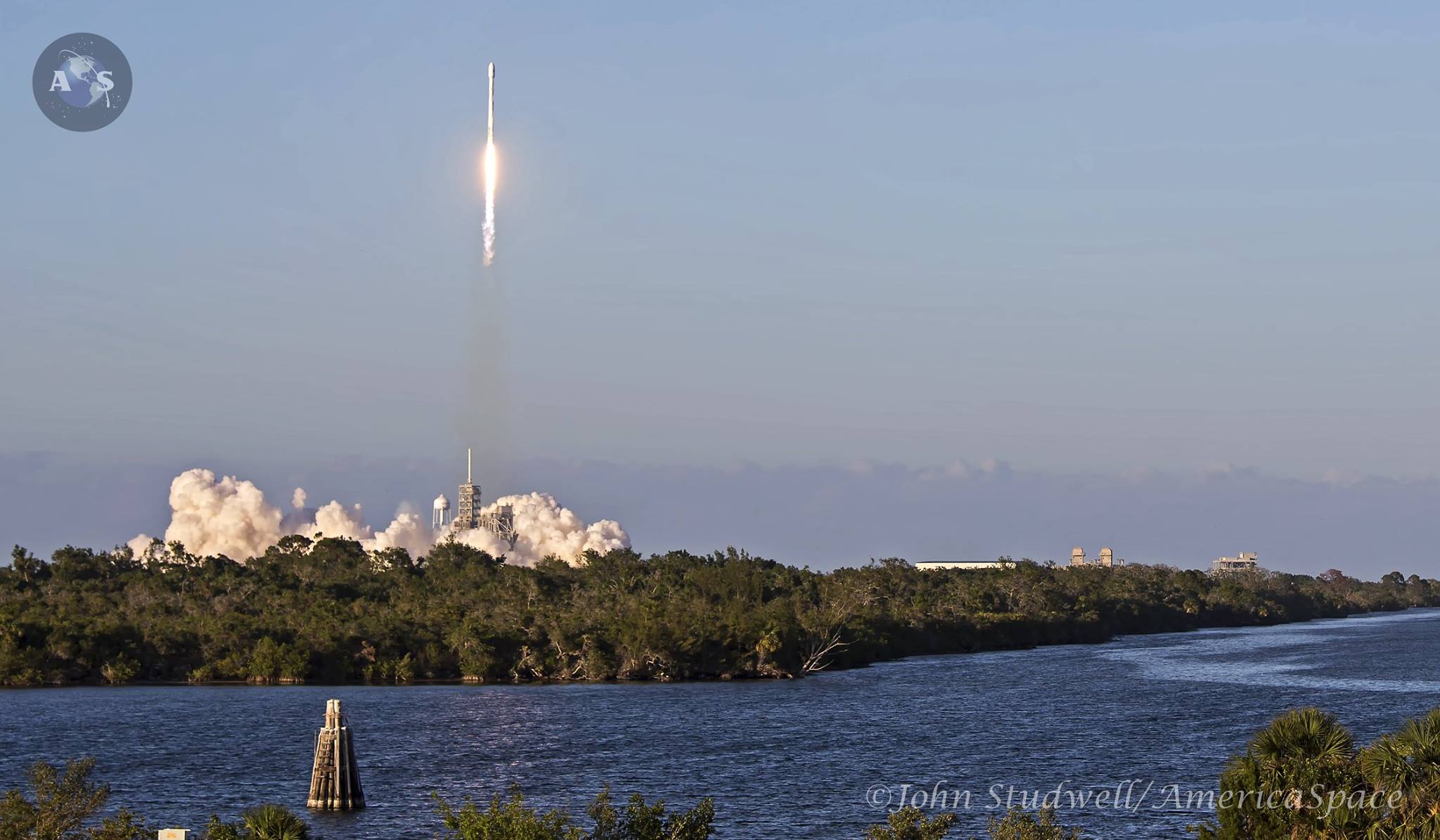
Four seconds shy of three minutes into tonight’s ascent, the Merlin 1D+ Vacuum engine ignited, producing 210,000 pounds (92,250 kg) of thrust. Shortly afterwards, the bulbous payload fairing was jettisoned, exposing Inmarsat 5-F4 to the high-vacuum environment of space for the first time. “Fairing deployment from @SpaceX Falcon 9,” exulted Inmarsat in a 7:27 p.m. EDT tweet. “Our #I5F4 satellite is getting ready to fly solo!”
The restartable engine was tasked with two discrete “burns”, the first of which ran for almost six minutes and ended with Stage Engine Cutoff (SECO-1) at 8.5 minutes after liftoff. This established the vehicle into an initial parking orbit. It then entered a protracted coast phase of almost 18 minutes, before the engine restarted a little over 26 minutes after departing KSC. This burn (SECO-2) was significantly shorter, lasting just 60 seconds, and established the proper conditions for the deployment of Inmarsat 5-F4 at 32 minutes into the flight.
Immediately after separating from the second stage of the Upgraded Falcon 9, the satellite came under the command of the Boeing and Inmarsat operations teams at the Boeing facility in El Segundo. In addition to maneuvering the payload into its geostationary location, some 22,236 miles (35,786 km) above Earth, their work also includes the deployment of antennas and the twin solar arrays, which span 133.2 feet (40.6 meters) when fully unfurled. It is expected that Inmarsat 5-F4 will remain operational for at least 15 years.
Be sure to “LIKE” AmericaSpace on Facebook and follow us on Instagram & Twitter!
.
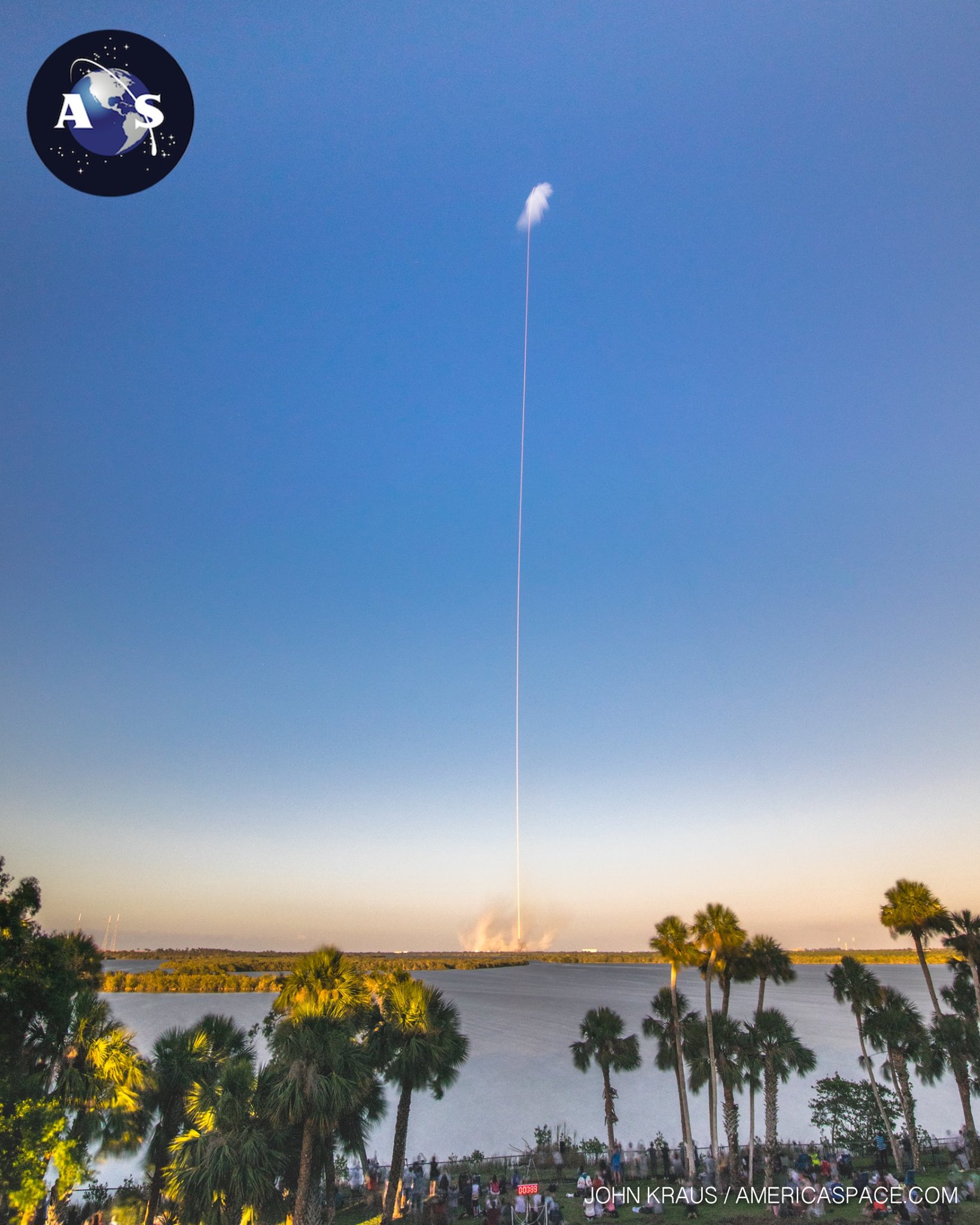
.




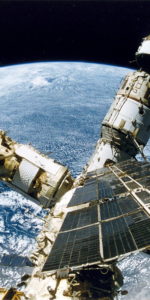

Congrats to the team on another successful launch. Hoping you have nailed down the launch cadence and start making launches boringly routine.
It looks like they are going to get their moneys worth from 39A.
Post launch shakedown is consistently conducive for 2 week cadence. Assuming SpaceX can keep cores coming (new or used), the pad seems like it isn’t breaking a sweat on this cadence. Interesting to see how it fares after first FH flight.